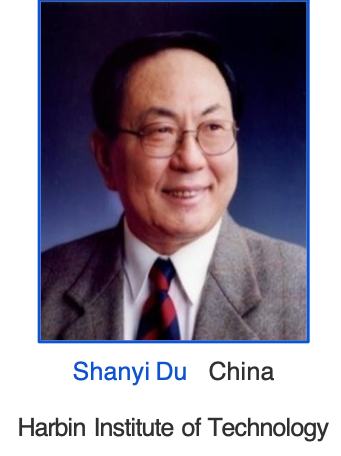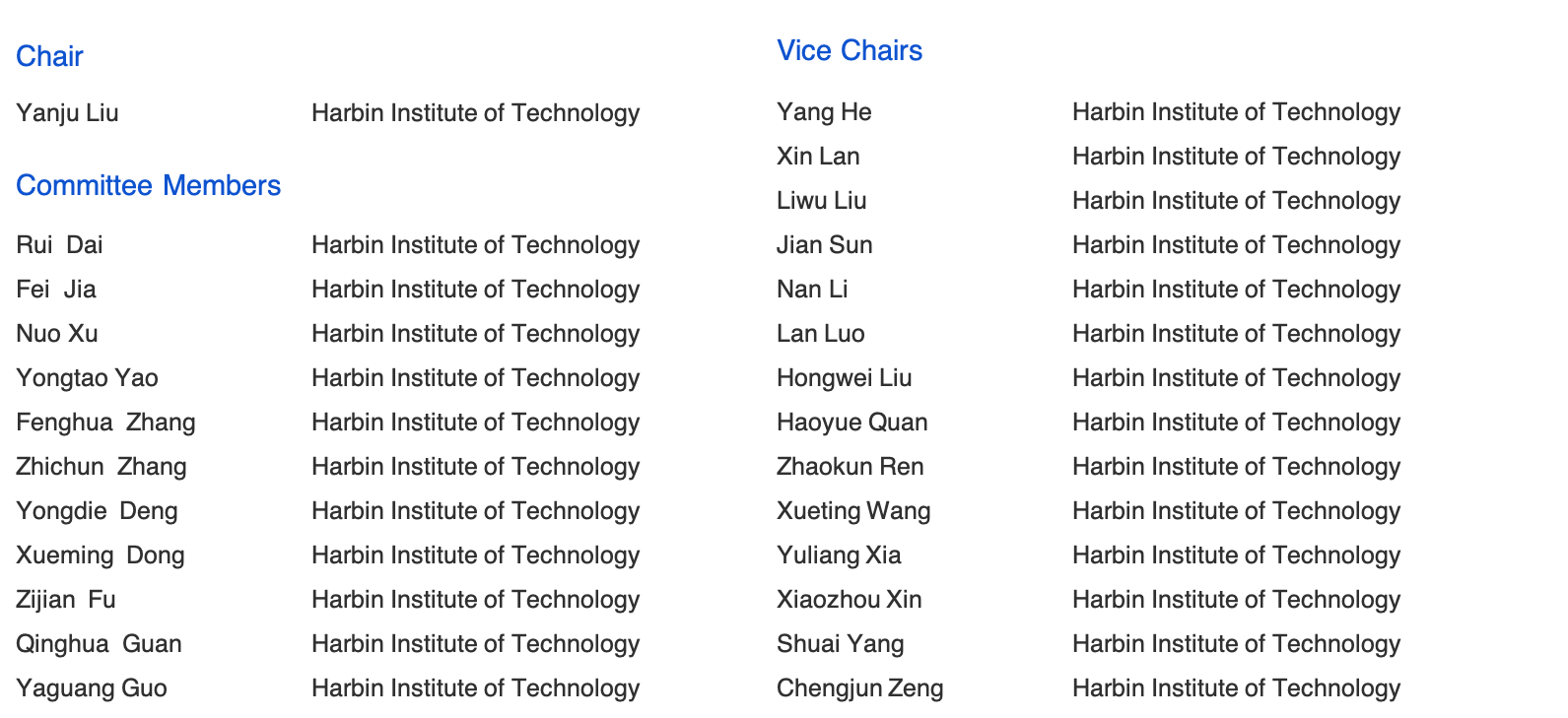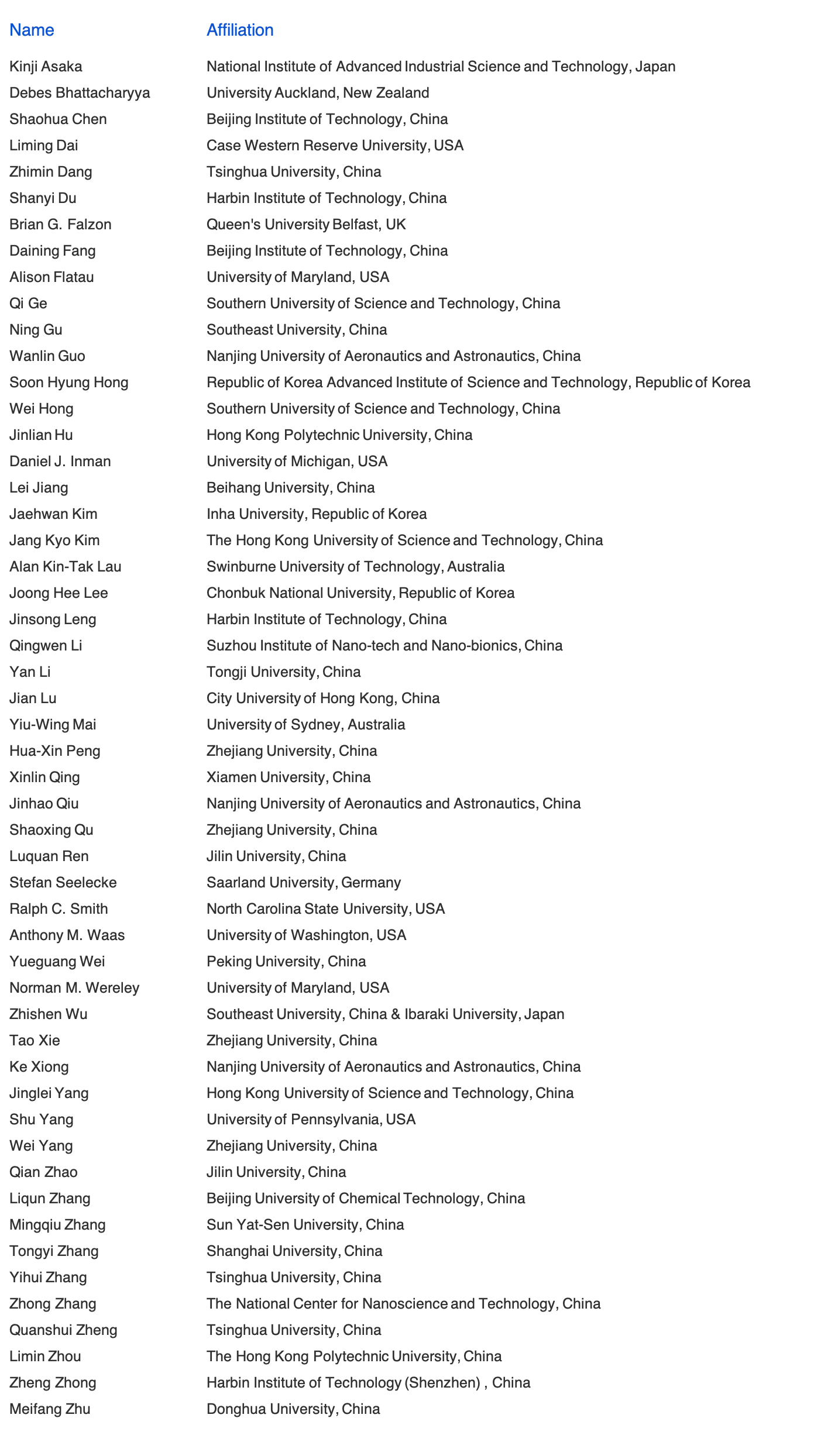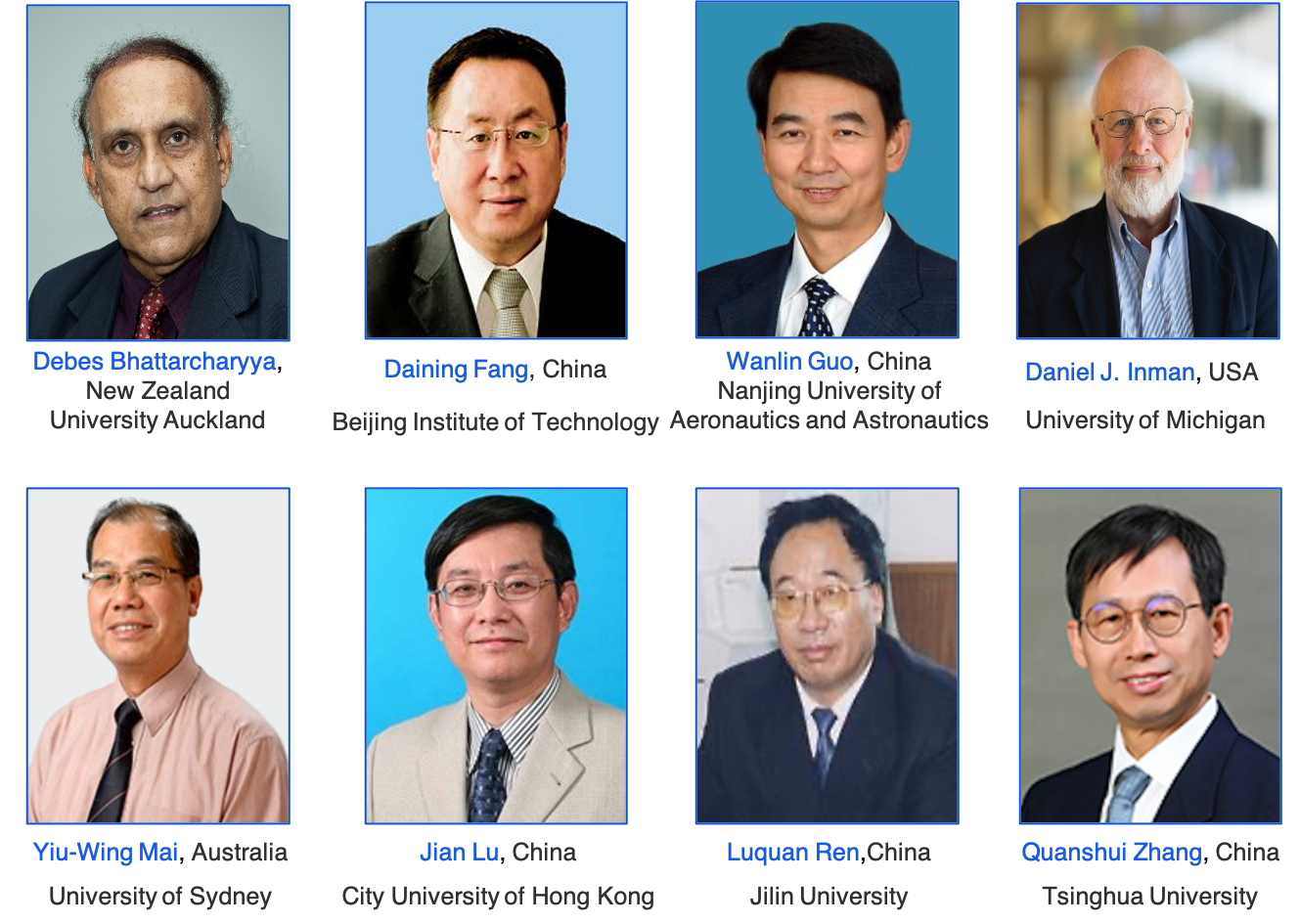HOME » SMN CONFERENCES » SMN2019
Smart Structure Competition
____________________________________________________________________________________________________
4D Printed Anisotropic Deformable Honeycomb Structures based on Shape Memory Polymer
A Bouncing Spherical Robot based on Smart Materials
A Pair of Smart High-heeled Shoes with Controllable Deformation
A Simple Way to Prepare Superhydrophobic Surface with Anti-icing Performance
Adaptive Three-Dimensional TWSMA Bump
Chiral Metastructures with Excellent Thermal Expansion Properties based on Multi-Material 3D Printing Technology
Flexible Non-Magneitc Motor Based on Polyacrylate Dielectric Elastomer
Modular Reconfigurable Robotics Based on Rapid-Manufacturable Wrinkled Pneumatic Artificial Muscles and Mortise-and-Tenon Joint Structures
The Modular External Limb Robot
Wearable Pneumatic Flexible External Limb
SMN2019 Best Student Paper Award
____________________________________________________________________________________________________
A Broadband Piezoelectric Energy Harvesting System for Intelligent Automobile Wheels
Authors: Xiaobo Rui, Yibo Li, Zhoumo Zeng
Affilication: Tianjin University, China
A New Materials Constitutive Framework for Elastic and Elastoplastic Material Based on Artificial Neural Network
Authors: Hang Yang, Shan Tang, Xu Guo
Affilication: Dalian University of Technology, China
Bending Behavior of Axially Functionally Graded Beams Integrated with Piezoelectric Actuators
Authors: Xiao Ma, Shuai Wang, Bo Zhou, Shifang Xue
Affilication: China University of Petroleum (East China), China
Chiral Metastructures with Excellent Thermal Expansion Properties Based on F Multi-Material 3D Printing Technology
Authors: Huabin Yu1, Wenwang Wu 1,2 Liwu Liu3, Jinsong Leng3, Daining Fang1
Affilication: 1 Beijing Institute of Technology, China
2 Massachusetts Institute of Technology, USA
3 Harbin Institute of Technology, China
Drop-Induced Shock Mitigation Using Adaptive Magnetorheological Energy Absorber
Authors: Mukai Wang1, Zhaobo Chen1, Norman M. Wereley2
Affilication: 1 Harbin Institute of Technology, China
2 University of Maryland, USA
Electric Field-Induced Directional Transportation and Effective Collection of Underwater Oil Droplet on the Gradient Porous Cone Surface
Authors: Yufeng Yan, Zhenyan Guo, Dongliang Tian, Lei Jiang
Affilication: Beihang University, China
Electrooculographic Signal Controlled Dielectric Elastomer Based Tunable
Authors: Lens Jinrong Li1, Yang Wang2, Liwu Liu1, Yanju Liu1, Jinsong Leng1 Shengqiang Cai2
Affilication: 1 Harbin Institute of Technology, China
2 University of California, USA
Investigation into the Structural and Mechanical Properties of Bamboo Microstructure through 3d Printing
Authors: Qifeng Li, Stepan V. Lomov, Larissa Gorbatikh
Affilication: KU Leuven, Belgium
Mechanical Responses of MoS Nanowires: A Molecular Dynamics Simulation Study
Authors: Penghua Ying1, Jin Zhang1, Jianli Zhou1, Zheng Zhong1
Affilication: Harbin Institute of Technology, Shenzhen, China
Origami and 4D Printing of Ceramics
Authors: Guo Liu, Yan Zhao, Ge Wu, Jian Lu
Affilication: City University of Hong Kong, China
Super-Alignment-Array CNT / Epoxy Nanocomposite and its Electrical Conductivity
Authors: Shengqiang Wang1, 2, Hui Zhang1, Zhong Zhang1
Affilication: 1 National Center of Nanoscience and Technology, China
2 University of Chinese Academy of Science, China
The Modulus Prediction of SMPC under Elevated Temperatures
Authors: Fengfeng Li1, Yanju Liu1, Jinsong Leng1, Fabrizio Scarpa2
Affilication: 1 Harbin Institute of Technology, China
2 University of Bristol, UK
Organization
____________________________________________________________________________________________________
Conference Chairs
Honorary Chair

Conference Co-Chairs

Organizing Committee
____________________________________________________________________________________________________

Academic Committee (The following names are arranged alphabetically by last name)
____________________________________________________________________________________________________

PENARY LECTURES (The following names are arranged alphabetically by last name)
____________________________________________________________________________________________________

Debes Bhattacharyya University of Auckland, New Zealand
Development of Graphene-Based Flexible Large Strain Sensors
Dr. Debes Bhattacharyya is a Distinguished Professor in the Department of Mechanical Engineering and until early 2016 was the founding Director of the Centre for Advanced Composite Materials at the University of Auckland. In 2016, he was felicitated as the Dr A P J Abdul Kalam Professor by SRM University in Chennai, India. He also held an Adjunct Professor position at Washington State University, Pullman, USA (2011–2017). Professor Bhattacharyya was the Head of Mechanical Engineering Department from 1999 to early 2005. His research interest includes the mechanics and manufacturing of composite materials with recent emphasis on flammability and bioengineering applications. He has held visiting positions at various universities in Australia, Canada, Germany, Hong Kong and the US, and has been awarded a number of international awards, including German Science Foundation Fellowship, Du Pont research award, Institute of Polymer Science Fellowship. He has delivered>65 keynote/plenary/ invited lectures at international conferences. He is currently the Editor and Associate Editor of three international journals and has served/is serving on the Editorial Advisory Boards of several journals. Prof. Bhattacharyya has about 475 scientific/technical publications including several edited/authored books and a number of book chapters. He has successfully implemented several international patents and has served as a reviewer for more than 40 journals and organizations. He is a Fellow of the Royal Society, NZ and a Distinguished Fellow of EngNZ. He was awarded an honorary ‘Doctor of Engineering’ (honoris causa) by the University of Southern Queensland, Australia in 2012. In that year he was awarded by EngNZ the Supreme Technical Award for his professional contributions. Apart from these he has received several civic awards including two gold medals at the House of Lords, London, UK and Capitol Hill, Washington D.C., USA.
Daining Fang Beijing Institute of Technology, China
Smart Structures: from 3D to 4D Printing
Professor Daining Fang, an Academician of Chinese Academy of Sciences, received Ph.D. from Technion-Israel Institute of Technology in 1993. After one-year postdoc at Tel Aviv University, and half a year visiting scholar at Maryland University, he has taught at Tsinghua University (1995-2009), Peking University (2009-2015) and Beijing Institute of Technology (2015-present). Professor Fang is an expert of Mechanics of Materials. His research focuses on the mechanical behaviors of advanced materials and structures under magneto-electro-thermal- mechanical multi-field coupling in the aspects of theory, calculation and experiment. He has extended the theory of macro- and micro-scopic deformation and fracture of ferroelectrics/ ferromagnetics which is applied in the FEM analysis and device design. He established the multi-field multi-scale calculation method and the design principle of light-weight multifunctional composites, and the manufactured structures have been used for the development of new defense-related equipment; He has also developed magneto-electro-thermal-mechanical multi-field coupling multi-axis loading and measuring technology and experimental methods, and converted the research results to dozens of scientific instruments with independent intellectual property rights. These instruments have been widely used for related scientific research in both China and abroad.
Wanlin Guo Nanjing University of Aeronautics and Astronautics, China
Intelligent Nano Materials and Technology
Dr. Wanlin GUO, Academician of Chinese Academy of Sciences, Chair Professor in mechanics and nanoscience, founder and director of the Key Laboratory of Intelligent Nano Materials and Devices of Ministry of Education and the Institute of Nanoscience of Nanjing University of Aeronautics and Astronautics. His current research focuses on intelligent nano materials and devices, novel conception and technology for efficient energy conversion, molecular physical mechanics for neuronal signaling and molecular biomimics, as well as strength and safety of aircraft and engine. He has published more than 400 peer-reviewed journal papers on Nature series, Phys. Rev. Lett., J. Am. Chem. Soc., Adv. Mater., J. Mech. Phys. Solids, Nano Lett., etc. He received the National Science Foundation of China for Distinguished Young Scholars in 1996 and the position of Cheung Kong Scholars in 1999. He obtained the National Nature Science Prize of China in 2012 for his contribution to physics mechanics, and the ICCES Eric Reissner Award in 2019 for his sustained contributions to the integrity and durability of aerospace structures, and to nano-mechanics.
Daniel J. Inman University of Michigan, USA
Morphing UAVs Using Smart Material Based Devices
Daniel J. Inman received his Ph.D. from Michigan State University in Mechanical Engineering in 1980 and is the Harm Buning Collegiate Professor of former Chair of the Department of Aerospace Engineering at the University of Michigan, Since 1980, he has published eight books (on vibration, energy harvesting, control, statics, and dynamics), eight software manuals, 20 book chapters, over 400 journal papers and 650 proceedings papers, given 64 keynote or plenary lectures, graduated 66 Ph.D. students and supervised more than 75 MS degrees. He works in the area of applying smart structures to solve aerospace engineering problems including energy harvesting, structural health monitoring, vibration suppression and morphing aircraft. He is a Fellow of AIAA, ASME, IIAV, SEM and AAM.
Quanshui Zheng Tsinghua University, China
Structural Superlubricity: from Nanomechanics to Nanodevices
Dr. ZHENG Quanshui has been a full professor at the Department of Engineering Mechanics, Tsinghua University, since 1993. He currently serves as the founding chief professor of the Tsien Excellence in Engineering Program (TEEP, 2009-) and the founding directors of Tsinghua University’s Center for Nano and Micro Michanics (2010- ) and Institute of Superlubricity Technology of Research Institute of Tsinghua University in Shenzhen (2018-). In the last two decades, Zheng’s main research interest is the interfacial mechanics and physics based on nanotechnology. In particular, he pioneered the technology and applications of structural superlubricity, a state of nearly zero friction and wear between two contacted solid surfaces, and the understanding on the instability and size effect of superhydrophobicity. During the 1980-1990’s, Zheng established the theory of representations for tensor functions and the invariant base of nonlinear and anisotropic constitutive equations and solved some long- lasting fundamental problems in continuum mechanics (such as Eshelby problem for non-ellipsoidal inclusions, micromechanical model, and Cauchy mean rotation).
Yiu-Wing Mai University of Sydney, Australia
High-Performance Epoxy-Based Composites as Underfill Materials for Electronic Packaging
Yiu-Wing Mai received his undergraduate and postgraduate degrees in mechanical engineering at the University of Hong Kong. He had worked at various times in the US (the University of Michigan and the NIST), the UK (Imperial College) and Hong Kong (CityU, HKU, HKUST and PolyU). He currently holds a University Chair in Mechanical Engineering at the University of Sydney. Prof Mai has major research interests on fracture and fatigue mechanics as well as processing-structure- property relationships of advanced composites based on polymer, ceramic, metal and cementitious matrices. He was elected to fellowships of the Royal Society of London, the UK Royal Academy of Engineering, the Australian Academy of Science, the Australian Academy of Technological Sciences and Engineering, the Hong Kong Academy of Engineering Sciences and the Chinese Academy of Engineering.
Jian Lu City University of Hong Kong, China
Multifunctional Nanomaterials and Supra-Nanomaterials: Concept, Processing and Applications
Prof. Jian Lu is Chair Professor of Mechanical Engineering; Vice-President (Research &Technology) and Dean of graduate study at the City University of Hong Kong (CityU). He obtained the Dip. Ing., Master (DEA) degree and Doctoral degree from University of Technology of Compiegne in 1984 and 1986 respectively. In 1994, he was appointed as Professor; Head of Department of Mechanical Systems Engineering and Director of Mechanical Systems and Concurrent Engineering Laboratory jointly supported by the French Ministry of Education and CNRS at the University of Technology of Troyes, France. From 2010 to 2013, he was the Dean of College of Science and Engineering at CityU. Professor LU’s primary research interest is advanced nanomaterials and its integration in mechanical and biomedical systems using the combination of experimental mechanics and mechanical simulation. He has published more than 350 SCI journal papers including papers in Nature (cover story), Science, Nature Materials, Nature Communications, Science Advances, Materials Today, Advanced Materials, PRL, Acta Materialia, and Journal of the Mechanics and Physics of Solids. He received the French Knight of the National Order of Merit and French Knight of the National Order of Légion d’Honneur in 2006 & 2017 respectively. He was elected as an academician by the National Academy of Technologies of France in 2011. He received the Guanghua Engineering Science and Technology Award from the Chinese National Academy of Engineering in 2018.
Luquan Ren Jilin University, China
3D/4D Printing of Bionic Intelligent Materials
Professor Luquan Ren is a Member of the Chinese Academy of Sciences (CAS), Vice-director of the Academic Board at Jilin University, Director of the Academic Board of the Key Laboratory for Bionic Engineering, Ministry of Education of China. He is also the executive vice chairman of the International Society of Bionic Engineering (ISBE), the national representative of the International Society of Ground Vehicle Systems (ISTVS), the vice chairman of the Asian Society of Agricultural Engineering, and the member of the Discipline (Machinery) Review Group of the Academic Degree Committee of the State Council. He also serves as editor-in-chief of Journal of Bionic Engineering, editor-in-chief of Journal of Jilin University. He has been engaged in bionic science and engineering for a long time. He is the chief scientist of the major projects of the National "Jump Plan" and the national "Instrument Development". As the first prize winner, he has won more than 13 first-class prizes at provincial and ministerial levels, including 2 National Second Prize for Technological Invention, 2 Second Prize for National Teaching Achievements. He also published 5 monographs and more than 400 academic papers.
Debes Bhattacharyya University of Auckland, New Zealand
Development of Graphene-Based Flexible Large Strain Sensors
Dr. Debes Bhattacharyya is a Distinguished Professor in the Department of Mechanical Engineering and until early 2016 was the founding Director of the Centre for Advanced Composite Materials at the University of Auckland. In 2016, he was felicitated as the Dr A P J Abdul Kalam Professor by SRM University in Chennai, India. He also held an Adjunct Professor position at Washington State University, Pullman, USA (2011–2017). Professor Bhattacharyya was the Head of Mechanical Engineering Department from 1999 to early 2005. His research interest includes the mechanics and manufacturing of composite materials with recent emphasis on flammability and bioengineering applications. He has held visiting positions at various universities in Australia, Canada, Germany, Hong Kong and the US, and has been awarded a number of international awards, including German Science Foundation Fellowship, Du Pont research award, Institute of Polymer Science Fellowship. He has delivered>65 keynote/plenary/ invited lectures at international conferences. He is currently the Editor and Associate Editor of three international journals and has served/is serving on the Editorial Advisory Boards of several journals. Prof. Bhattacharyya has about 475 scientific/technical publications including several edited/authored books and a number of book chapters. He has successfully implemented several international patents and has served as a reviewer for more than 40 journals and organizations. He is a Fellow of the Royal Society, NZ and a Distinguished Fellow of EngNZ. He was awarded an honorary ‘Doctor of Engineering’ (honoris causa) by the University of Southern Queensland, Australia in 2012. In that year he was awarded by EngNZ the Supreme Technical Award for his professional contributions. Apart from these he has received several civic awards including two gold medals at the House of Lords, London, UK and Capitol Hill, Washington D.C., USA.
Daining Fang Beijing Institute of Technology, China
Smart Structures: from 3D to 4D Printing
Professor Daining Fang, an Academician of Chinese Academy of Sciences, received Ph.D. from Technion-Israel Institute of Technology in 1993. After one-year postdoc at Tel Aviv University, and half a year visiting scholar at Maryland University, he has taught at Tsinghua University (1995-2009), Peking University (2009-2015) and Beijing Institute of Technology (2015-present). Professor Fang is an expert of Mechanics of Materials. His research focuses on the mechanical behaviors of advanced materials and structures under magneto-electro-thermal- mechanical multi-field coupling in the aspects of theory, calculation and experiment. He has extended the theory of macro- and micro-scopic deformation and fracture of ferroelectrics/ ferromagnetics which is applied in the FEM analysis and device design. He established the multi-field multi-scale calculation method and the design principle of light-weight multifunctional composites, and the manufactured structures have been used for the development of new defense-related equipment; He has also developed magneto-electro-thermal-mechanical multi-field coupling multi-axis loading and measuring technology and experimental methods, and converted the research results to dozens of scientific instruments with independent intellectual property rights. These instruments have been widely used for related scientific research in both China and abroad.
Wanlin Guo Nanjing University of Aeronautics and Astronautics, China
Intelligent Nano Materials and Technology
Dr. Wanlin GUO, Academician of Chinese Academy of Sciences, Chair Professor in mechanics and nanoscience, founder and director of the Key Laboratory of Intelligent Nano Materials and Devices of Ministry of Education and the Institute of Nanoscience of Nanjing University of Aeronautics and Astronautics. His current research focuses on intelligent nano materials and devices, novel conception and technology for efficient energy conversion, molecular physical mechanics for neuronal signaling and molecular biomimics, as well as strength and safety of aircraft and engine. He has published more than 400 peer-reviewed journal papers on Nature series, Phys. Rev. Lett., J. Am. Chem. Soc., Adv. Mater., J. Mech. Phys. Solids, Nano Lett., etc. He received the National Science Foundation of China for Distinguished Young Scholars in 1996 and the position of Cheung Kong Scholars in 1999. He obtained the National Nature Science Prize of China in 2012 for his contribution to physics mechanics, and the ICCES Eric Reissner Award in 2019 for his sustained contributions to the integrity and durability of aerospace structures, and to nano-mechanics.
Daniel J. Inman University of Michigan, USA
Morphing UAVs Using Smart Material Based Devices
Daniel J. Inman received his Ph.D. from Michigan State University in Mechanical Engineering in 1980 and is the Harm Buning Collegiate Professor of former Chair of the Department of Aerospace Engineering at the University of Michigan, Since 1980, he has published eight books (on vibration, energy harvesting, control, statics, and dynamics), eight software manuals, 20 book chapters, over 400 journal papers and 650 proceedings papers, given 64 keynote or plenary lectures, graduated 66 Ph.D. students and supervised more than 75 MS degrees. He works in the area of applying smart structures to solve aerospace engineering problems including energy harvesting, structural health monitoring, vibration suppression and morphing aircraft. He is a Fellow of AIAA, ASME, IIAV, SEM and AAM.
Quanshui Zheng Tsinghua University, China
Structural Superlubricity: from Nanomechanics to Nanodevices
Dr. ZHENG Quanshui has been a full professor at the Department of Engineering Mechanics, Tsinghua University, since 1993. He currently serves as the founding chief professor of the Tsien Excellence in Engineering Program (TEEP, 2009-) and the founding directors of Tsinghua University’s Center for Nano and Micro Michanics (2010- ) and Institute of Superlubricity Technology of Research Institute of Tsinghua University in Shenzhen (2018-). In the last two decades, Zheng’s main research interest is the interfacial mechanics and physics based on nanotechnology. In particular, he pioneered the technology and applications of structural superlubricity, a state of nearly zero friction and wear between two contacted solid surfaces, and the understanding on the instability and size effect of superhydrophobicity. During the 1980-1990’s, Zheng established the theory of representations for tensor functions and the invariant base of nonlinear and anisotropic constitutive equations and solved some long- lasting fundamental problems in continuum mechanics (such as Eshelby problem for non-ellipsoidal inclusions, micromechanical model, and Cauchy mean rotation).
Yiu-Wing Mai University of Sydney, Australia
High-Performance Epoxy-Based Composites as Underfill Materials for Electronic Packaging
Yiu-Wing Mai received his undergraduate and postgraduate degrees in mechanical engineering at the University of Hong Kong. He had worked at various times in the US (the University of Michigan and the NIST), the UK (Imperial College) and Hong Kong (CityU, HKU, HKUST and PolyU). He currently holds a University Chair in Mechanical Engineering at the University of Sydney. Prof Mai has major research interests on fracture and fatigue mechanics as well as processing-structure- property relationships of advanced composites based on polymer, ceramic, metal and cementitious matrices. He was elected to fellowships of the Royal Society of London, the UK Royal Academy of Engineering, the Australian Academy of Science, the Australian Academy of Technological Sciences and Engineering, the Hong Kong Academy of Engineering Sciences and the Chinese Academy of Engineering.
Jian Lu City University of Hong Kong, China
Multifunctional Nanomaterials and Supra-Nanomaterials: Concept, Processing and Applications
Prof. Jian Lu is Chair Professor of Mechanical Engineering; Vice-President (Research &Technology) and Dean of graduate study at the City University of Hong Kong (CityU). He obtained the Dip. Ing., Master (DEA) degree and Doctoral degree from University of Technology of Compiegne in 1984 and 1986 respectively. In 1994, he was appointed as Professor; Head of Department of Mechanical Systems Engineering and Director of Mechanical Systems and Concurrent Engineering Laboratory jointly supported by the French Ministry of Education and CNRS at the University of Technology of Troyes, France. From 2010 to 2013, he was the Dean of College of Science and Engineering at CityU. Professor LU’s primary research interest is advanced nanomaterials and its integration in mechanical and biomedical systems using the combination of experimental mechanics and mechanical simulation. He has published more than 350 SCI journal papers including papers in Nature (cover story), Science, Nature Materials, Nature Communications, Science Advances, Materials Today, Advanced Materials, PRL, Acta Materialia, and Journal of the Mechanics and Physics of Solids. He received the French Knight of the National Order of Merit and French Knight of the National Order of Légion d’Honneur in 2006 & 2017 respectively. He was elected as an academician by the National Academy of Technologies of France in 2011. He received the Guanghua Engineering Science and Technology Award from the Chinese National Academy of Engineering in 2018.
Luquan Ren Jilin University, China
3D/4D Printing of Bionic Intelligent Materials
Professor Luquan Ren is a Member of the Chinese Academy of Sciences (CAS), Vice-director of the Academic Board at Jilin University, Director of the Academic Board of the Key Laboratory for Bionic Engineering, Ministry of Education of China. He is also the executive vice chairman of the International Society of Bionic Engineering (ISBE), the national representative of the International Society of Ground Vehicle Systems (ISTVS), the vice chairman of the Asian Society of Agricultural Engineering, and the member of the Discipline (Machinery) Review Group of the Academic Degree Committee of the State Council. He also serves as editor-in-chief of Journal of Bionic Engineering, editor-in-chief of Journal of Jilin University. He has been engaged in bionic science and engineering for a long time. He is the chief scientist of the major projects of the National "Jump Plan" and the national "Instrument Development". As the first prize winner, he has won more than 13 first-class prizes at provincial and ministerial levels, including 2 National Second Prize for Technological Invention, 2 Second Prize for National Teaching Achievements. He also published 5 monographs and more than 400 academic papers.
KEYNOTE LECTURES (The following names are arranged alphabetically by last name)
____________________________________________________________________________________________________

